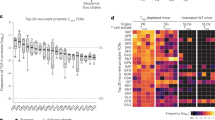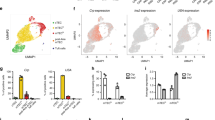Abstract
Experiments with chimaeric animals have demonstrated that the H–2 restriction specificity and immune response (Ir) gene phenotype of the T cell is acquired during development in the thymus. The mechanism by which this process occurs is unclear. One level of obligate expression of H–2 and Ir gene products is on the surface of antigen-presenting cells (APCs) which come from bone marrow precursors. We have now examined the turnover of APCs in the thymuses of F1→parent (P) radiation-induced bone marrow chimaeras and found that APCs of donor phenotype appear at about 2 months after reconstitution. If the peripheral T-cell population is depleted after this time, new T cells emerging from the parental thymus (containing F1 APCs) behaved like F1 T cells, suggesting that cells from the bone marrow can influence thymic-directed T-cell differentiation. The thymic APC is an attractive candidate to play such a part in the development of the T-cell repertoire.
This is a preview of subscription content, access via your institution
Access options
Subscribe to this journal
Receive 51 print issues and online access
$199.00 per year
only $3.90 per issue
Buy this article
- Purchase on Springer Link
- Instant access to full article PDF
Prices may be subject to local taxes which are calculated during checkout
Similar content being viewed by others
References
Yano, A., Schwartz, R. H. & Paul, W. E. Eur. J. Immun, 8, 334–338 (1978).
Kappler, J. W. & Marrack, P. J. exp. Med. 148, 1510–1522 (1978).
Hodes, R. J., Hathcock, K. S. & Singer, A. J. Immun. 123, 2823–2829 (1979).
Longo, D. L. & Schwartz, R. H. J. exp. Med. 151, 1452–1467 (1980).
Zinkernagel, R. M. et al. J. exp. Med. 148, 592–610 (1978).
Von Boehmer, H., Haas, W. & Jerne, N. K. Proc. natn. Acad. Sci. U.S.A. 75, 2439–2442 (1978).
Matsunaga, J. & Simpson, E. Proc. natn. Acad. Sci. U.S.A. 75, 6207–6212 (1978).
Billings, P., Burakoff, S. J., Dorf, M. E. & Benacerraf, B. J. exp. Med. 148, 352–359 (1978).
Hedrick, S. M. & Watson, J. J. exp. Med. 150, 646–659 (1979).
Longo, D. L. & Schwartz, R. H. Fedn Proc. 39, 1127 (1980).
Zinkernagel, R. M. Immun. Rev. 42, 224–270 (1978).
Jenkinson, E. J., Owen, J. J. T. & Aspinall, R. Nature 284, 177–179 (1980).
Beller, D. I. & Unanue, E. J. Immun. 121, 1861–1866 (1978).
Rouse, R. V., van Ewijk, W., Jones, P. P. & Weissman, I. L. J. Immun. 122, 2508–2515 (1979).
Frelinger, J. G., Hood, L., Hill, S. & Frelinger, J. A. Nature 282, 321–324 (1979).
Katz, S. I., Tamaki, K. & Sachs, D. H. Nature 282, 324–326 (1979).
Smith, F. I. & Miller, J. F. A. P. J. exp. Med. 151, 246–251 (1980).
Author information
Authors and Affiliations
Rights and permissions
About this article
Cite this article
Longo, D., Schwartz, R. T-cell specificity for H–2 and Ir gene phenotype correlates with the phenotype of thymic antigen-presenting cells. Nature 287, 44–46 (1980). https://doi.org/10.1038/287044a0
Received:
Accepted:
Issue Date:
DOI: https://doi.org/10.1038/287044a0
This article is cited by
-
Development and characterization of a continuous macrophage cell line, LRTM, derived from thymus of Labeo rohita (Hamilton 1822)
In Vitro Cellular & Developmental Biology - Animal (2014)
-
Thymic stromal cell specialization and the T-cell receptor repertoire
Immunologic Research (1997)
-
Clonal deletion of immature CD4+8+ thymocytes in suspension culture by extrathymic antigen-presenting cells
Nature (1991)
-
Does T-cell tolerance require a dedicated antigen-presenting cell?
Nature (1989)
-
Deletion of self-reactive T cells before entry into the thymus medulla
Nature (1988)
Comments
By submitting a comment you agree to abide by our Terms and Community Guidelines. If you find something abusive or that does not comply with our terms or guidelines please flag it as inappropriate.



